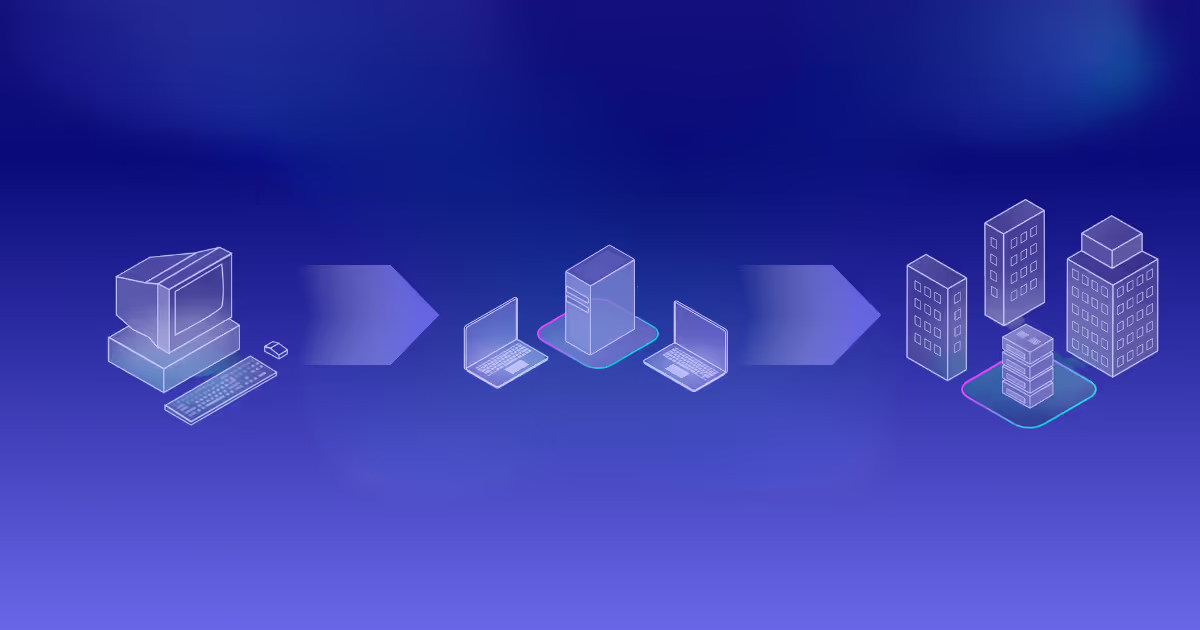



Cloud Series: Future State of Technology
A fundamental transformation is occurring in the gaming industry as we witness a transition from on-premise technology infrastructure to leading data centers. This evolution in our industry is essential for its survival and organizations who embrace it will continue to be competitive. In this four-part article series, we will dive into aspects of this transformation.
This article seeks to educate our readers on the future state of technology.
Modern Infrastructure for Modern Software
Modern software relies on modern infrastructure. You can’t expect that old Nokia phone you once loved to support the hundreds of apps you use on your iPhone today, any more than you can expect on-premise infrastructure to support modern software that relies on big data processing capabilities, automated deployments, and leading security features.
Technology advancements have built upon one another since the 1960s, leading to distributed computing, cloud computing, the Artificial Intelligence (AI) transformation, and onward into the future.

The AI transformation is grounded in the cloud, and all advancements in the foreseeable future will continue to build upon this framework.
Future State of Technology
The AI transformation will define the technology landscape of the future. Bill Gates recently said, “We’re seeing a fundamental advancement as important as any in the history of digital technology.” There is a tidal wave of money going into AI, with the largest cloud providers investing billions into their infrastructure to better support AI and reengineering their software applications to fully leverage this new capability.
We have already seen some big winners in this space. OpenAI was the original breakout success and is a leader in productizing AI through its partnership with Microsoft and others. We now see other AI models seeing traction and success with integrations into leading technology providers. NVIDIA is dominating the AI data processing space, with any company hoping to compete with OpenAI ordering NVIDIA hardware.
Much of the innovation we expect to experience in the future will be centered on addressing a persistent challenge: data processing. Technology has advanced from personal computing to distributed computing to hyper-scalable cloud computing. These advancements increased the speed at which we could process data, deploy updates, and ultimately increased the speed of innovation.
While the cloud is a fundamental advancement in computing, the data processing needs of the future run into a significant challenge: data centers are expensive and consume a massive amount of energy resources. As the planet adopts technology that uses vast amounts of computing resources, we will see innovations that both decrease the need for new data centers, while taking steps forward in technological capabilities.
Here are four of these advancements to watch:
Neural Processing Unit (NPU)
Neural Processing Units (NPUs) are a specialized type of microprocessor designed to simulate a human brain’s neural network and accelerate computation, which are a fundamental component of many modern AI and machine learning (ML) applications. This is a significant advancement because data processing can occur in real-time on a user’s local device instead of at a data center hundreds of miles away.
By simulating a human brain’s neural network, NPUs can process large amounts of data in parallel, performing trillions of operations per second. These processors use far less power than a CPU (Central Processing Unit) or GPU (Graphics Processing Unit) for complex calculations, freeing up these other processors for more routine tasks.
We will start to see these on our personal computers, cars, phones, home devices, and in data centers. The following are some interesting applications of NPUs coming in the near future:
Mobile Devices:
NPUs enable features like real-time image and video processing, augmented reality (AR), and voice recognition, while maintaining battery efficiency. Imagine being able to interact with vocally ChatGPT embedded in your phone to act as a true personal assistant, or having apps produce interactive holograms or augmented reality like those seen in an Iron Man movie.
Autonomous Vehicles:
NPUs process sensor data from cameras, lidars, and radars to help the vehicle understand its environment and make driving decisions in real-time. This will greatly advance the capabilities of driverless cars and assist drivers with notifications, data presentations, and so forth.
Smart Home Devices:
NPUs in smart speakers and home assistants enhance voice recognition and enable more responsive and accurate AI-driven features. We may one day be able to have a true Tony Stark experience at home with augmented reality and a Jarvis of our own.
Software Application:
NPUs in laptops or desktop computers will allow users to interact with personal and work software applications by voice or via augmented reality. Instead of interacting with software through a traditional mouse and keyboard, users will be able to just talk with it.
Data Centers:
NPUs in data centers accelerate the training and inferences of large AI models, improving the performance of services like search engines, recommendation systems, and natural language processing.
Serverless Computing
Cloud providers have invested significant resources to fully automate infrastructure management. This allows companies to focus on their software and services while enabling the cloud provider to fully manage the infrastructure. Cloud providers are incentivized to optimize the use of infrastructure in order to limit their need to build more data centers, which are expensive to build and maintain. In the future, cloud providers will innovate in this area and automate infrastructure management to further optimize the use of resources. This will reduce the resources needed to manage cloud services and allow businesses to put even more focus on their core software or services.
Quantum Computing
Cloud providers are heavily investing in quantum computing. This is a fundamental shift in how data is processed by reducing the need for vast amounts of servers to process data and providing near infinite computing power.
Quantum computing harnesses the principles of quantum mechanics to process information in profoundly new ways. Unlike classical computers, which use bits (0 or 1) to process data, quantum computers use quantum bits or qubits. Qubits can exist simultaneously in multiple states and can be entangled with each other, enabling computations that are simply not possible using only 0 or 1.
Quantum computers can compute in minutes tasks that would take classical computing millions of years to complete. The ability to analyze vast amounts of data simultaneously will revolutionize machine learning and big data analytics, enabling more accurate predictions, insights, and greatly reduce the amount of infrastructure needed. Additionally, quantum computers can simulate molecular and chemical reactions, which is valuable in the science and pharmaceutical industries.
Data security can also be enhanced with quantum computing by creating virtually unbreakable quantum cryptography methods, making existing encryption systems irrelevant.
Along with quantum computing, Microsoft is working with scientists on an initiative to write data on synthetic DNA.1 The project has been successful in storing data on DNA, but they are working to resolve slow reading and writing capabilities to make this a viable technology. According to recent articles, synthetic DNA storage would allow all of the world’s data across global data centers to fit into something the size of a shoe box or even an object as small as a ping pong ball.2
The combination of synthetic DNA storage with quantum computing could be a powerful combination that would result in near infinite compute and storage capabilities.
Security and Compliance Capabilities
Data security and compliance is mission-critical to cloud providers. Companies, governments, and any other organization will only use cloud services if there is a high confidence in data security and compliance. Billions of dollars is being spent by cloud providers in this area and new innovations around AI and quantum computing will also contribute to advancements in security. Data security and compliance continue to be key areas of focus as the technology landscape evolves.
Get the White Paper
Start growing
Discover how Kinectify can clear the way for you to scale your business.







.avif)
